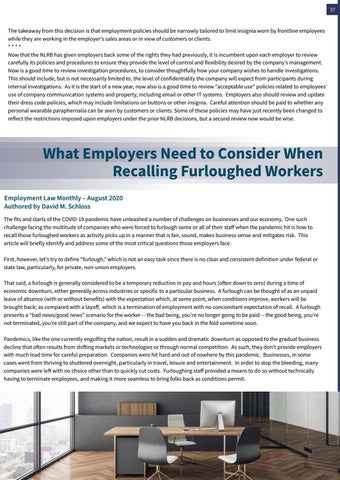37 The takeaway from this decision is that employment policies should be narrowly tailored to limit insignia worn by frontline employees while they are working in the employer’s sales areas or in view of customers or clients. **** Now that the NLRB has given employers back some of the rights they had previously, it is incumbent upon each employer to review carefully its policies and procedures to ensure they provide the level of control and flexibility desired by the company’s management. Now is a good time to review investigation procedures, to consider thoughtfully how your company wishes to handle investigations. This should include, but is not necessarily limited to, the level of confidentiality the company will expect from participants during internal investigations. As it is the start of a new year, now also is a good time to review “acceptable use” policies related to employees’ use of company communication systems and property, including email or other IT systems. Employers also should review and update their dress code policies, which may include limitations on buttons or other insignia. Careful attention should be paid to whether any personal wearable paraphernalia can be seen by customers or clients. Some of these policies may have just recently been changed to reflect the restrictions imposed upon employers under the prior NLRB decisions, but a second review now would be wise.
What Employers Need to Consider When Recalling Furloughed Workers Employment Law Monthly – August 2020 Authored by David M. Schloss The fits and starts of the COVID-19 pandemic have unleashed a number of challenges on businesses and our economy. One such challenge facing the multitude of companies who were forced to furlough some or all of their staff when the pandemic hit is how to recall those furloughed workers as activity picks up in a manner that is fair, sound, makes business sense and mitigates risk. This article will briefly identify and address some of the most critical questions those employers face. First, however, let’s try to define “furlough,” which is not an easy task since there is no clear and consistent definition under federal or state law, particularly, for private, non-union employers. That said, a furlough is generally considered to be a temporary reduction in pay and hours (often down to zero) during a time of economic downturn, either generally across industries or specific to a particular business. A furlough can be thought of as an unpaid leave of absence (with or without benefits) with the expectation which, at some point, when conditions improve, workers will be brought back; as compared with a layoff, which is a termination of employment with no concomitant expectation of recall. A furlough presents a “bad news/good news” scenario for the worker -- the bad being, you’re no longer going to be paid -- the good being, you’re not terminated, you’re still part of the company, and we expect to have you back in the fold sometime soon. Pandemics, like the one currently engulfing the nation, result in a sudden and dramatic downturn as opposed to the gradual business decline that often results from shifting markets or technologies or through normal competition. As such, they don’t provide employers with much lead time for careful preparation. Companies were hit hard and out of nowhere by this pandemic. Businesses, in some cases went from thriving to shuttered overnight, particularly in travel, leisure and entertainment. In order to stop the bleeding, many companies were left with no choice other than to quickly cut costs. Furloughing staff provided a means to do so without technically having to terminate employees, and making it more seamless to bring folks back as conditions permit.

















